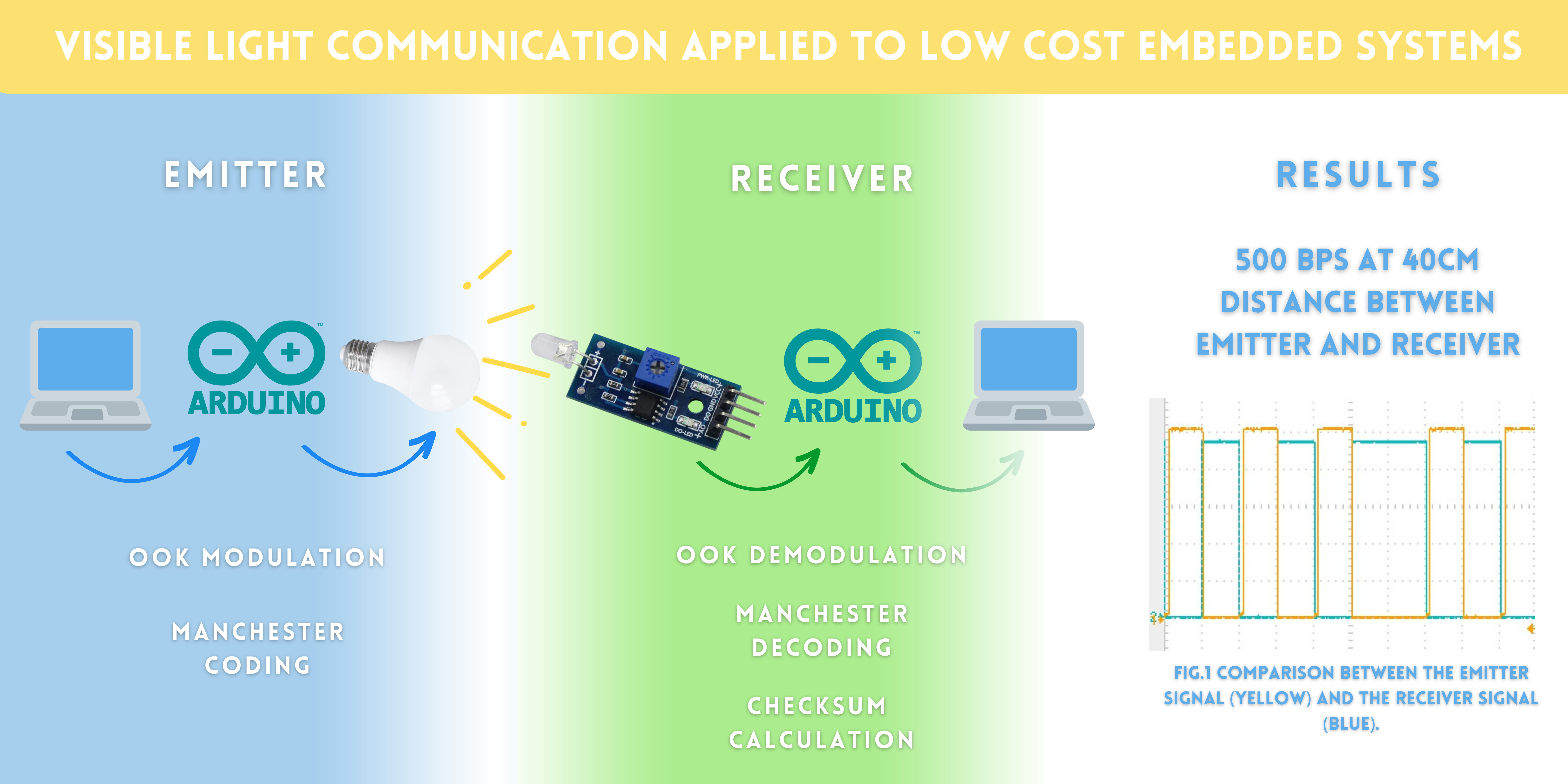Visible Light Communication Applied to Low Cost Embedded Systems
Keywords:
VLC, Embedded Systems, ArduinoAbstract
The growing and continuous evolution of communication around the world, mainly due to the Internet of Things, has brought new perspectives on techniques for exchanging data. Visible Light Communication (VLC), a technology that uses Light-Emitting-Diodes (LEDs) modulation to send data, has become an alternative to radiofrequency, since its bandwidth is becoming scarce. This article proposes a didactic application of VLC using low-cost embedded systems, like off-the-shelf components and two Arduinos UNO. In addition, this application features On-Off Keying (OOK) modulation and Manchester Code as techniques for sending data and calculating the checksum for verifying the message correctness. In this approach, we reach a communication rate of 500 bps, at a distance of 40 cm. In addition, all hardware design e software code were provided.
Downloads
References
G. A. Mapunda, R. Ramogomana, L. Marata, B. Basutli, A. S. Khan, and J. M. Chuma, “Indoor visible light communication: A tutorial and
survey,” Wireless Communications and Mobile Computing, vol. 2020, 2020.
N. Sklavos, M. Hubner, D. Goehringer, and P. Kitsos, ¨ System-level design methodologies for telecommunication. Springer, 2013.
W. Ding, F. Yang, H. Yang, J. Wang, X. Wang, X. Zhang, and J. Song, “A hybrid power line and visible light communication system for indoor hospital applications,” Computers in industry, vol. 68, pp. 170–178, 2015.
L. Tamazirt, F. Alilat, and N. Agoulmine, “A visible light communication based positioning system for intuitive advertising in supermarkets,” in 5th International Workshop on ADVANCEs in ICT Infrastructures and Services (ADVANCE 2017), 2017.
Y. Shen, G. Chen, X. Xu, C. Xu, G. Shen, and J. Li, “Poster: A vlc solution for smart parking,” in Proceedings of the 23rd Annual International Conference on Mobile Computing and Networking, 2017, pp. 579–581.
D. Krichene, M. Sliti, W. Abdallah, and N. Boudriga, “An aeronautical visible light communication system to enable in-flight connectivity,” in 2015 17th International Conference on Transparent Optical Networks (ICTON). IEEE, 2015, pp. 1–6.
A. Bazzi, B. M. Masini, A. Zanella, and A. Calisti, “Visible light communications as a complementary technology for the internet of vehicles,” Computer Communications, vol. 93, pp. 39–51, 2016.
B. Soner and S. Coleri, “Visible light communication based vehicle localization for collision avoidance and platooning,” IEEE Transactions
on Vehicular Technology, vol. 70, no. 3, pp. 2167–2180, 2021.
A. G. Bell, “The photophone,” Science, no. 11, pp. 130–134, 1880.
T. Komine and M. Nakagawa, “Fundamental analysis for visible-light communication system using led lights,” IEEE T. Consum. Electr., vol. 50, no. 1, pp. 100–107, 2004.
M. Kavehrad, “Sustainable energy-efficient wireless applications using light,” IEEE Commun. Mag., vol. 48, no. 12, pp. 66–73, 2010.
H. Haas, “Lifi is a paradigm-shifting 5g technology,” Reviews in Physics, vol. 3, pp. 26–31, 2018.
W. Yuanquan and C. Nan, “A high-speed bi-directional visible light communication system based on rgb-led,” China Communications, vol. 11, no. 3, pp. 40–44, 2014.
K. James Singh, Y.-M. Huang, T. Ahmed, A.-C. Liu, S.-W. Huang Chen, F.-J. Liou, T. Wu, C.-C. Lin, C.-W. Chow, G.-R. Lin et al., “Micro-led
as a promising candidate for high-speed visible light communication,” Applied Sciences, vol. 10, no. 20, p. 7384, 2020.
F. Zafar, M. Bakaul, and R. Parthiban, “Laser-diode-based visible light communication: Toward gigabit class communication,” IEEE Commun. Mag., vol. 55, no. 2, pp. 144–151, 2017.
M. S. Islim, R. X. Ferreira, X. He, E. Xie, S. Videv, S. Viola, S. Watson, N. Bamiedakis, R. V. Penty, I. H. White et al., “Towards 10 gb/s orthogonal frequency division multiplexing-based visible light communication using a gan violet micro-led,” Photonics Res., vol. 5, no. 2, pp. A35–A43, 2017.
S. Fuada, A. P. Putra, and T. Adiono, “Analysis of received power characteristics of commercial photodiodes in indoor los channel visible
light communication,” 2017.
P. P. Manousiadis, K. Yoshida, G. A. Turnbull, and I. D. Samuel, “Organic semiconductors for visible light communications,” Philosophical Transactions of the Royal Society A, vol. 378, no. 2169, p. 20190186, 2020.
T.-H. Do and M. Yoo, “Visible light communication-based vehicle-tovehicle tracking using cmos camera,” IEEE Access, vol. 7, pp. 7218–
, 2019.
R. M. Mare, C. E. Cugnasca, C. L. Marte, and G. Gentile, “Intelligent `transport systems and visible light communication applications: An overview,” in 2016 IEEE 19th Int. Conf. Intell. Transp. Syst. (ITSC). IEEE, 2016, pp. 2101–2106.
D. A. Lima and A. C. Victorino, “Sensor-based control with digital maps association for global navigation: A real application for autonomous vehicles,” in Intelligent Transportation Systems (ITSC), 2015 IEEE 18th International Conference on, Sept 2015, pp. 1791 1796.
G. Hernandez-Oregon, M. E. Rivero-Angeles, J. C. Chimal-Egu´ıa, A. Campos-Fentanes, J. G. Jimenez-Gallardo, U. O. Estevez-Alva, O. Juarez-Gonzalez, P. O. Rosas-Calderon, S. Sandoval-Reyes, and R. Menchaca-Mendez, “Performance analysis of v2v and v2i lifi communication systems in traffic lights,” Wireless Communications and Mobile Computing, vol. 2019, 2019.
H. B. Eldeeb, M. Elamassie, and M. Uysal, “Vehicle-to-infrastructure visible light communications: Channel modelling and capacity calculations,” in 2020 12th International Symposium on Communication Systems, Networks and Digital Signal Processing (CSNDSP). IEEE, 2020, pp. 1–6.
D. Aguirre, R. Navarrete, I. Soto, and S. Gutierrez, “Implementation of an emitting led circuit in a visible light communications positioning system,” in 2017 First South American Colloquium on Visible Light Communications (SACVLC). IEEE, 2017, pp. 1–4.
P. A. P. Ferraz and I. S. Santos, “Visible light communication applied on vehicle-to-vehicle networks,” in 2015 International Conference on Mechatronics, Electronics and Automotive Engineering (ICMEAE). IEEE, 2015, pp. 231–235.
J. Latal, T. Stratil, S. Hejduk, F. Sarlej, J. Kolar, L. Hajek, and A. Vanderka, “Implementation of vlc within a public lighting network,” in 2020 22nd International Conference on Transparent Optical Networks (ICTON). IEEE, 2020, pp. 1–5.
A. L. R. Gonc¸alves, “Software de emissão e recepção para ˜sistema vlc utilizando sistemas embarcados de baixo custo,” https://github.com/analuisarg/SistemaVLC, Feb. 2023.


